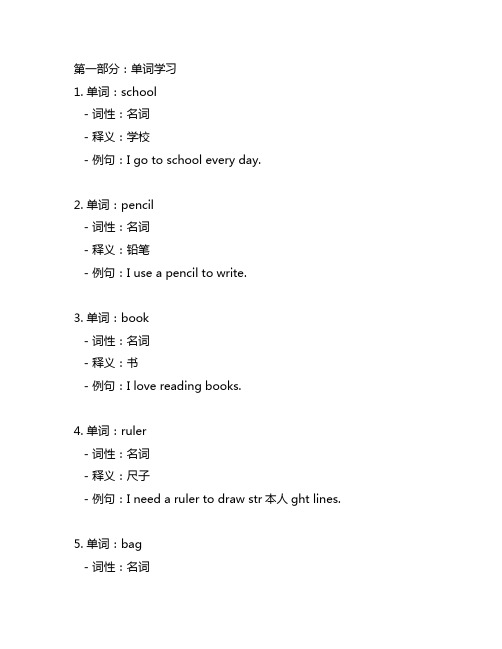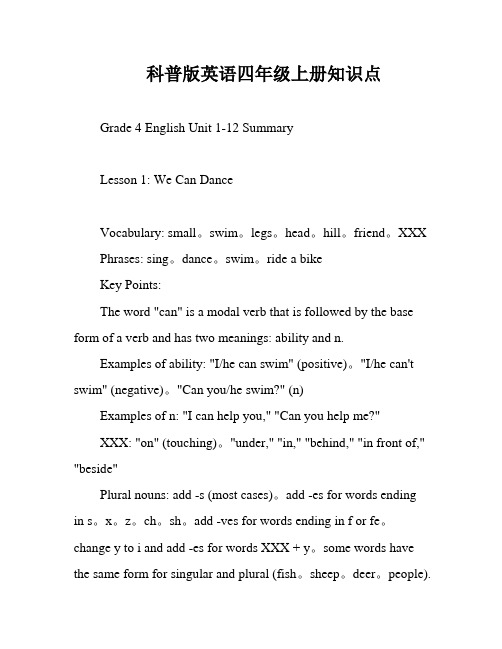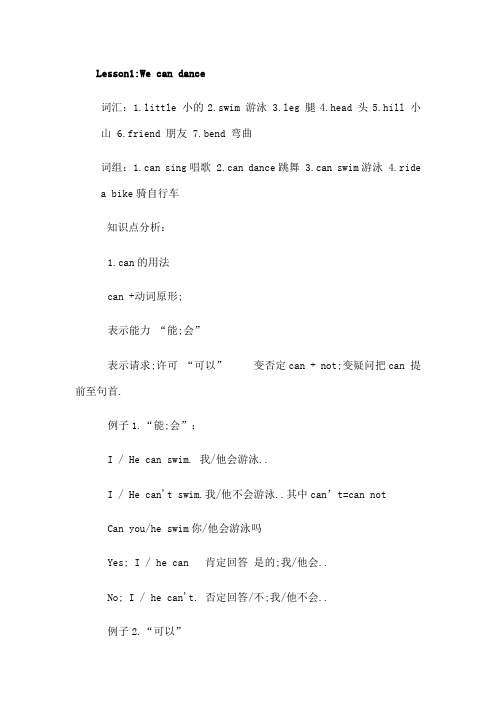科普版小学四年级上册英语
四年级上册英语科普版第七课单词和课文

第一部分:单词学习1. 单词:school- 词性:名词- 释义:学校- 例句:I go to school every day.2. 单词:pencil- 词性:名词- 释义:铅笔- 例句:I use a pencil to write.3. 单词:book- 词性:名词- 释义:书- 例句:I love reading books.4. 单词:ruler- 词性:名词- 释义:尺子- 例句:I need a ruler to draw str本人ght lines.5. 单词:bag- 词性:名词- 释义:书包- 例句:I carry my books in my bag.第二部分:课文学习本课主要介绍了日常学校用品的名称和使用场景。
通过教学内容的学习,学生能够了解学校用品的英文名称,并能够熟练运用这些用品的词汇进行日常交流。
在课文中,老师可以通过图片、视瓶等形式展示学校用品,搭配相应的英文单词进行学习,激发学生学习英语的兴趣,增强他们的记忆和语言应用能力。
1. 课文内容简介本课介绍了学校用品的单词,如school, pencil, book等,并通过对话形式展示了这些用品的使用场景,让学生在课文中感受到了实际运用这些用品的情景,从而加深对单词的理解和记忆。
2. 学习方法建议在教学中,老师可以采用多媒体教学的方式,如图片、视瓶等,让学生直观地了解学校用品的名称和外观,同时搭配相应的英文单词进行学习。
在课堂上可以设置角色扮演的活动,让学生在实际情景中运用所学的单词,增强他们的语言表达能力。
3. 练习题目- 请用英文说出你每天上学都需要用到的学校用品。
- 请用英文描述你在学校的一天,包括使用学校用品的场景。
4. 拓展练习- 请同学们自行搜集并介绍其他不在课文中出现的学校用品的英文名称,并和同学们共享。
- 请同学们以小组形式设计一个关于学校用品的英语对话,并在课堂上表演。
5. 小结通过本课的学习,学生在掌握学校用品的英文名称的也能够在实际情景中运用这些单词,提高他们的语言运用能力。
科普版英语四年级上册知识点

科普版英语四年级上册知识点Grade 4 English Unit 1-12 SummaryLesson 1: We Can DanceVocabulary: small。
swim。
legs。
head。
hill。
friend。
XXX Phrases: sing。
dance。
swim。
ride a bikeKey Points:The word "can" is a modal verb that is followed by the base form of a verb and has two meanings: ability and n.Examples of ability: "I/he can swim" (positive)。
"I/he can't swim" (negative)。
"Can you/he swim?" (n)Examples of n: "I can help you," "Can you help me?"XXX: "on" (touching)。
"under," "in," "behind," "in front of," "beside"Plural nouns: add -s (most cases)。
add -es for words endingin s。
x。
z。
ch。
sh。
add -ves for words ending in f or fe。
change y to i and add -es for words XXX + y。
some words have the same form for singular and plural (fish。
[四年级英语]科普版小学英语四年级上册第一二单元
![[四年级英语]科普版小学英语四年级上册第一二单元](https://img.taocdn.com/s3/m/f6411175ad02de80d4d84034.png)
Unit 1
I can swim
小学四年级英语上册第一单元
什么,疑问 It 一般代指植物和无 Unit 1 生命的事物,代指人 代词,常用于疑问 时指婴儿或者双方都 句,对未知事物的 知道到的人。 提问。如,what’s in your hand? 如:who’s that? 大学生补习班 六点钟:指阳中心小学 6 o’clock It’s Tom . 段丹珍 董改娜 watch :手表 clock :钟表
I can swim
瞧,鱼小姐,我会 chicken: Look, Hi,Miss Fish !I can bend my leg and 弯曲我的腿和头, my head.Can you? Unit 1 你会吗? 不,我不会。 Fish:No ,I can’t. 瞧,鱼小姐,我会 Cat: Look, Hi,Miss Fish ! 跑到那座山,你会 I can swim I can run up the hill.Can 吗? you ? 大学生补习班 指阳中心小学 段丹珍 不,我不会。 Fish:No, I can’t. 董改娜 哈哈 H C:Haha
.
what
什么
.
desk
书桌 名词
.
some
一些
.
cup
茶杯 名词
.
guess
猜 动词
.
clock
w
钟表 名词
.
sorry
对不起 动词
.
come
来 动词
.
one
一个
.
one
two
一 二
.
three four
三 四
.
five six
五 六
科普版四年级英语上册期末知识点总结

Lesson1:We can dance词汇:1.little 小的2.swim 游泳 3.leg 腿4.head 头5.hill 小山 6.friend 朋友 7.bend 弯曲词组:1.can sing唱歌 2.can dance跳舞 3.can swim游泳 4.ridea bike骑自行车知识点分析:1.can的用法can +动词原形;表示能力“能;会”表示请求;许可“可以”变否定can + not;变疑问把can 提前至句首.例子1.“能;会”:I / He can swim. 我/他会游泳..I / He can't swim.我/他不会游泳..其中can’t=can notCan you/he swim你/他会游泳吗Yes; I / he can 肯定回答是的;我/他会..No; I / he can't. 否定回答/不;我/他不会..例子2.“可以”I can help you.我可以帮助你Can you help me你可以帮助我吗一般疑问句;肯定回答 Yes; I/we can是的;我们可以;否定回答No ;I/we can’t不;我们不可以..Lesson2: What's on the desk词汇:1.what 什么2.desk 书桌 3.some一些 4.cup茶杯5.clock 钟6.sorry 对不起 7e 来 8.one 一 9.guess 猜;猜出词组:on the bed在床上 in the box在盒子里 in the room在房间里知识点分析:1.介词小结:..on在…上面接触;under在..下面;In在…里面;behind在…后面; in front of在…前面;beside 在…旁边..2.名词单数变复数:名词单数变复数;直接加 -s 占多数;s; x; z; ch; sh 来结尾;直接加上 es;词尾是 f 或 fe;加 s 之前先变 ve;辅母 + y 在词尾;把 y 变 i 再加 es;词尾字母若是 o;常用三个已足够;要加 es 请记好;hero; tomato; potato..例如:clock钟表---clocks复数;doll洋娃娃—dolls复数peach桃子---peaches复数;fox狐狸---foxes复数leaf叶子—leaves复数;knife小刀---knives复数body身体—bodies复数另外还有单复数同形词单数和复数一样的词fish鱼;sheep绵羊;deer鹿;people人;人们..3. 区分一般疑问句和特殊疑问句:例如a:Is this a doll 这是一个洋娃娃吗肯定回答:Yes; it is. 是的;它是.否定回答:No; it is not或者缩写为No; it isn’t. 不;它不是..b: Can you touch your head and bend your leg你能弯曲你的腿和触碰你的头吗肯定回答:Yes; I can. 是的;我能..否定回答:No; I can not或者缩写为No; I can’t.不;我不能..特殊疑问句..例如:What’s in the box盒子里有什么It’s a clock.一个钟表..Lesson3:Is this your bag词汇: 1.look 看2.book 书 3.good 好的4.pen 钢笔5.pencil 铅笔 6.pencil-box文具盒词组:your knife 你的小刀; my book我的书; his ruler他的尺子;her crayon她的蜡笔..知识点分析:1.常见的物主代词:“......的”第一人称 my mine our ours第二人称 your yours your yours第三人称 his his their theirs2. “Is this”和” Is that”用法:Is this/that ...“表示这是/那是...吗”其答语是:Yes; it is. 是的;它是..No; it isn't.不;它不是..e.g. ①--Is this your pencil这是你的铅笔吗--Yes; it is. 是的;它是..②—Is that her pencil-box 那是她的文具盒吗--No; it isn’t .不;它不是..3.a 和 an例如:a ruler 一把尺子 a pen一支钢笔a pencil 一支铅笔 an eraser 一块橡皮a book一本书 an apple一个苹果Lesson4:Is he your brother词汇:1.sister 姐妹2.brother 兄弟3.have 有4.happy 高兴的;幸福的 5.panda 熊猫 6.family家;家庭 7.mother母亲 8. girl女孩词组:家庭成员类:my father我的爸爸;my mother我的妈妈;my uncle 我的叔叔;my aunt我的阿姨;姑姑;my brother我的兄弟;my sister我的姐妹;my grandfather我的爷爷;祖父;my grandmother我的奶奶;祖母..知识点分析:1.介绍家庭“This is my family”:介绍家庭成员 This is my father.2. 询问某人身份“Who's he/she”表示“他/她是谁”其答语为:“He/She's....他/她是....”e.g. 1.--Who's he他是谁-- He is my dad. 他是我的爸爸..2. --Who is she 她是谁-- She is my sister; 她是我的姐姐..3.确认他人身份:Is he / she ...Yes; he / she is. No; he / she isn't.Is he your brother Yes; he is. No; he isn't.Lesson5:What can you see词汇: 1.read 读 2.please 请 3.see 看见;看到 4.green 绿色的5.tree6.many 许多7.three 三8.meet 遇见9.sheep 绵羊 10 any 任何词组:green tree绿树; come in进来;black and yellow黑黄相间的知识点分析:1.常见易错单词的复数:单复数同形词单复数一样的词:fish—fish鱼;sheep—sheep绵羊;people-people 人;人们;deer-deer鹿..2.I—we;我-我们;/ you-you 你-你们 / it ;he ;she—they它/他/她—他们This-these这个-这些 / that-those那个-那些..3.can的用法:肯定形式: I can see否定形式:I can’t see一般疑问形式:Can you see… ----Yes; I can/ No; I can’t.Can I… ---- Yes; you can/ No ; you can’t.特殊疑问形式:What can you see ---- I can see……Lesson6:Revision词汇: 1.morning 早晨;上午 2.ball 球 3.Mr. 先生 4.bird 鸟5.hurt 疼痛 6.doctor 医生 7.horse 马 8.cook 厨师 9.worker 工人10.nurse 护士 11.tall 高的词组:fly a kite放风筝; a brown bag一个棕色的包;Let’s go让我们出发知识点分析:1.Let’s let’s = let us让我们..例如:Let’s go swimming让我们去游泳Let’s go to school.让我们去上学吧Let’s go and fly the kite now.让我们现在出发去放风筝吧..2. Who's he/she 表示“他/她是谁”其答语为:He's/She's....“他是/她是.....”3.首次见面用语:----Nice to meet you. ---Nice to meet you ;too. Lesson7:Is he a doctor or a nurse词汇:teacher教师;worker工人;woman女人复数women;doctor医生;or或者;否则;nurse护士;driver司机;cook厨师;farmer农民..词组:my sister我的姐姐;in the room在房间里..知识点分析:1. “Who”引导的特殊疑问句以及其回答:Who is she她是谁She is my sister.她是我姐姐..Who are they她们是谁They are my sisters.她们是我姐妹们..2. Are you...表示“你是...吗”其答语用Yes或No来回答..3.选择疑问句:提出两种或两种以上的情况;要求对方选择一种情况回答;这种问句叫做选择疑问句;选择疑问句的两种或两种以上的情况用or连接;回答时不能用yes或no;语调一般是第一种选择用升调;最后一种选择用降调..例如:Is she a doctor or a nurseShe is a nurse.Lesson8:What’s the time词汇: 1.time 时间 2.eight 八 3.all 全;都 4.right 正确的5.seven 七te 晚的;迟的7.again 再;又8.play玩;戏剧 9.day 白天;日子 10.Sunday 星期日 11.today今天..词组:one o’clock一点整;late again再次迟到; That's all right.没关系;不用谢知识点分析:一周七天的表达:首字母大写周一:Monday; 周二:Tuesday; 周三:Wednesday; 周四:Thursday周五:Friday; 周六:Saturday; 周日:Sunday2.询问时间的两种方法:What time is it / What’s the timeIt’s eight o’clock.Lesson9:How many horses can you see词汇: 1.house房子2.horse马3.besidezai ......旁边4.six六5.cow奶牛6.eleven十一7.twelve十二8.thirteen十三9.fifteen十五10.over在....那边;结束11.goat山羊词组:over there在那边、how many有多少、not…..but….不是......而是......知识点分析:1.How many和How much:how much 修饰不可数名词和询问价钱“多少钱”;how many 修饰可数名词的复数..例如: .How many horses can you see询问可数名词---I can see fourteen.How much is the eraser--- It’s 2 Yuan.2.many 和 some:many和some在作为形容词时;都是表示数量的多少.. .some 的意思是“有些;一些;不少;很多” 一般用于肯定句中;来修饰可数名词和不可数名词..many表示;许多的;很多的..用来修饰可数名词;通常用在否定句和疑问句例如:①I have some English books.我有一些英语书..book是可数②How many birds in the tree 树上有多少鸟Lesson10:Where is my dog词汇: 1.find 找到 2.where 哪里;在哪里3.near 在...附近4.here 这里;这儿 5.car 小汽车 6.there那里;那儿 7.under在...下面8.chair 椅子 9.dear亲爱的词组:near here在这附近;under the chair在椅子下面;my dear dog 我亲爱的狗;come here过来知识点分析:1. Where引导的特殊疑问句;需要具体回答..意为:“…在哪里它在….”例如:Where is he他在哪里 ---he is in the car.他在汽车里..Where are you你在哪里 ---I’m here 我在这里..Where are my shoes我的鞋子在哪里 ----They are under your chair.它们在你椅子下面..2.find 找到I can find…. / I can’t find…./ Can you find..Lesson11:What’s this in English词汇: 1.bus公共汽车2. car 小汽车 3.aunt姑;姨;舅母等4.plane 飞机5.jeep吉普车;train火车;ship轮船;boat小船..词组:excuse me打扰了;对不起、in English用英语、toy bus玩具公共汽车知识点分析:1.想引起对方的注意或者打扰一下可以用: Excuse me.2.对于“What’s your name” “你叫什么名字的几种回答:What’s your name---I’m…/ I am …/ My name is…我叫…;我的名字是….名字3.“这个用英语怎么说”/“那个用英语怎么说”的回答都是“它是…”What’s this in English ---It’s a toy bus.What’s that in English ---It’s an ora nge.Lesson12:Revision词汇: 1. uncle叔;伯;舅等2.farmer农民3.work工作4.want想要5.plant植物6.do做7.bread面包8.eat吃wheat麦子10.together一起11.cut切;砍词组:have to 不得不、you are welcome不客气、do it together 一起做、like to work喜欢工作、 near the house在房子附近、plant wheat种植小麦知识点分析:1. 常见的几种“感谢”;几种“ 不客气”感谢:Thanks / Thank you / Thank you very much / Thanks a lot 等不客气:Not at all / That’s all right /That’s OK /You are welcome.等2. .How 意为“多么;如何”例如:How nice on a ship.在轮船上真好玩..How are you 你好吗你如何呢How old are you你几岁了你多大了But how但是如何做呢How nice it is好棒哦3.too 的用法:a.用于句尾;意为“也”例如:I can help you.我能帮助你..--- I can help you; too..我也能帮助你..b.用于句中;做形容词“太…”例如:But Mum; it’s too short.但是妈妈;它太短了..1.want的用法:want后面可以跟名词单复数或是动词词组 to dodo可替换为其他动词例如:want an apple想要一个苹果want some books想要一些书want to eat想要吃 / want to help you想要帮助你等..。
科普版四年级上册英语全册教学课件

一个钟? 不是。 一个洋娃娃? 不是。
科普版四年级 | 上册
Qiqi: Sorry, I can’t guess it. Lulu: Look! It’s you.
对不起,我猜不到它。 看!是你。
科普版四年级 | 上册
A clock
What’s on the desk?
科普版四年级 | 上册
科普版四年级 | 上册
Homework
科普版四年级 | 上册
所学单词写5遍。熟读所学对话, 会运用句型进行对话。
谢谢观看!
Lesson 7
Is she a doctor or a nurse
科普版四年级 | 上册
Listen look and say
科普版四年级 | 上册
horse /hɔ:s/ 马
tall /tɔ:l/ 高的
clock /klɒk/
Listen look and say
科普版四年级 | 上册
bed /bed/
Listen look and say
科普版四年级 | 上册
doll /dɒl/
Listen look and say
科普版四年级 | 上册
box /bɒks/
Let's talk
Qiqi: What's on the desk? Lulu: Some cups. 桌子上是什么? 一些茶杯。
科普版四年级 | 上册
Let’s talk
Hello, Liu Xing. Who’s he?
科普版四年级 | 上册
He’s my father.
Who’s she?
科普版四年级 | 上册
She’s my mother.
科普版小学英语四年级上册全册教案

科普版小学英语四年级上册全册教案科普版小学英语四年级上册全册教案目录《Lesson 1 We can dance》 (2)《Lesson 2 What's on the desk》 (6)《Lesson 3 Is this your bag》 (10)《Lesson 4 Is he your brother》 (14)《Lesson 5 What can you see》 (19)《Lesson 6 Revision》 (24)《Lesson 7 Is she a doctor or a nurse》 (27)《Lesson 8 What's the time》 (33)《Lesson 9 How many horses can you see》 (40)《Lesson 10 Where is my dog》 (46)《Lesson 11 What's this in English》 (54)《Lesson 1 We can dance》1教学目标一、知识目标:词汇:cook draw drive a car play the pianoride a bike speak English type write Chinese语法:I can ……. I can’t …….--- Can you ……?---Yes, I can./ No, I can’t.二、情感目标:学生学会用can 或can’t 来表达自己能做什么不能做什么,来向同学们展示自己的能力。
2学情分析小学四年级的学生和低年级学生相比具有比较强的自行探究的能力,学生在观察能力、思维能力、语言表达能力方面都有了较好的提高,有着强烈的好奇心与动手操作的能力。
他们喜欢在自己的探索中获取知识,喜欢在玩中学,喜欢在做中学,喜欢在想中学,喜欢在用中学。
对周边的事物产生着浓厚的兴趣,有着强烈的学习愿望,但不能自觉地从生活中进行学习,也不能很好地把语文知识用于生活中。
科普版四年级英语上册教案+同步练习

Lesson 1 We can dance◆教材分析This lesson is the first lesson of the textbook, which is to learn the pronunciation of I, and to learn the words and sentences that students should master.◆教学目标【知识与能力目标】You can hear the words "swim", "sing", "dance" and "ride a bike". “Can you ... ?” To communicate with others, to develop students' English ability in the process of learning.【过程与方法目标】To understand and master sentence patterns and to make sentences and applications with alternative words. We can dance. Let’s swim. —Can you sing?—Yes, we can./ No, I can’t.【情感态度价值观目标】To stimulate students' interest in learning English through various kinds of teaching activities and cultivate students' sense of cooperation.◆教学重难点◆【教学重点】Understand and master sentence patterns.We can dance.Let’s swim.—Can you sing?—Yes, we can / No,I can’t.【教学难点】Can be used to make sentences and applications.◆教学过程Step 1. Warming upHello! Boys and girls! Let’ s play a game. (Look at the picture!)T: What are these? Who can?Ss: Swim sing dance ride a bike...Step 2. TeachingA. vocabulary teachingDraw a simple picture on the blackboard. Read it twice and demonstrate it. Practice: group practice, group practice, single line practice, personal practice.Look, I can sing. Let the students imitate. I can sing and read. "Swim" and "ride a bike".B. pattern teachingT: I can swim. can you swim?Use your fingers to talk. Can you swim? yes, I can.Step 3. PracticeLet’s say a chant. Can you swim? yes, I can.Can you fly? No, I can’t.Can you ride a bike? Yes, I can.Step 4. Let's talkHi, my little friends!Hi, Miss Fish!Let's swim, OK?Oh, we can't swim.Can you touch your head and bend your leg?No, we can't. But we can dance.We can dance, too. Let's dance.Great!Step 5. Homework1. Copy the words on page 5 and 2 of each line.2. Listen to the first lesson and recite the text.◆教学反思略。
科普版小学四年级上册英语教学资料

科普版小学四年级上册英语教学资料第一课:问候与自我介绍- 课程目标:研究基本的问候和自我介绍的表达方式,培养口语交流能力。
- 教学内容:- 问候语:Hello、Hi、Good morning、Good afternoon、Good evening- 自我介绍:My name is...,I am...years old,I am from...- 教学方法:通过角色扮演、游戏等形式激发学生的兴趣,提高研究积极性。
第二课:数字与颜色- 课程目标:研究基本的数字和颜色的表达方式,培养数学和视觉辨别能力。
- 教学内容:- 数字:1-20,通过数学游戏和数字演唱会巩固记忆。
- 颜色:红色、蓝色、黄色、绿色、橙色、紫色,通过涂色活动和颜色搭配游戏加深理解。
- 教学方法:结合多媒体教学,使用图片和视频进行互动,提高学生的研究效果。
第三课:家庭与职业- 课程目标:研究家庭成员和职业的表达方式,了解家庭和社会的联系。
- 教学内容:- 家庭成员:father、mother、brother、sister,通过家谱图和游戏巩固记忆。
- 职业:doctor、teacher、student、driver,通过角色扮演和职业卡片游戏认知职业与相关动作。
- 教学方法:通过情景教学,引导学生进行角色扮演,加深理解和记忆。
第四课:动物与食物- 课程目标:研究常见动物和食物的表达方式,培养动物保护和健康饮食意识。
- 教学内容:- 动物:dog、cat、bird、elephant,通过动物展览和询问游戏巩固知识。
- 食物:apple、banana、juice、cake,通过食物制作和品尝活动加深理解。
- 教学方法:通过实物展示和实际操作,增加研究的趣味性和互动性。
以上是科普版小学四年级上册英语教学资料的大致内容,希望对您有所帮助。
如需更详细的教学设计,请随时告知。
- 1、下载文档前请自行甄别文档内容的完整性,平台不提供额外的编辑、内容补充、找答案等附加服务。
- 2、"仅部分预览"的文档,不可在线预览部分如存在完整性等问题,可反馈申请退款(可完整预览的文档不适用该条件!)。
- 3、如文档侵犯您的权益,请联系客服反馈,我们会尽快为您处理(人工客服工作时间:9:00-18:30)。
科普版小学四年级上册英语教案
Lesson 1 I can swim
一、教学内容和要求:
辅音音标[b][p][m][f][d][t][n][l][ɡ][k]语音 [h][r][s][z][v][w] 元音音标[i][e] 字母组合 ea 读作[e] little,swim,leg,head,hill 词汇 friend,bend hop,skate skip,gift I/He can swim.语言结构I/He can’t swim. Can you/he swim? Yes,I/he can./No,I/he can’t.交际用语I can swim.Can you? No,I can’t.
二、第一课时:能听懂、会说,并能用来进行会话能理解和掌握,并能用替换词造句和
运用
第二课时:能听懂、会说、会认读并能根据中文拼写出英文
第三课时:能听懂、会说、会认读
第四课时:能只要求能听懂和认读只要求能拼读,不要求知道词义能拼读含这些音标
和字母组合的单词。
三、课时安排(Teaching Arrangement):本课教学内容安排 4 个课时。
Listen,point and read,学习 16 个辅音音标及元音音标[e][i] Let’s talk 前半部分Let’s talk的剩余部分和Let’s sing Let’s learn,Listen and tick 和 A game
四、各课时的教学内容和步骤:
第一课时
(1)复习检查: A.复习元音字母 a,e,i,o,u 在闭音节单词中的读音:教师提问,让学生说闭音节单词的结构,以及 5 个元音字母在闭音节中的读音[?][e][i][? ]。
B.复习 b,p,m,f,d,t,n,1,g,k,h,r,s,z,v,w 16 个辅音字母在单词中的读音:教师板书这 16 个字母,然后提问,学生答。
C.学生拼读含[e][i]音和以上 16 个辅音的单词:教师板书 e 和 i,让学生读出它们在闭音节中的读音,然后让他们拼读下列单词:vest,help,bed,big,fish,with,chick,is,in, him 等。
(2)导入新课:四英 1 Listen,point and read,学习 18 个辅音音标及元音音标[e][i] A.介绍音标:告诉学生,刚才复习的 e,i,b,p,m,f 等字母在单词中的读音,叫做音素,用书面符号将它们记录下来,便是音标。
我们学用的是国际音标,共有 48 个,本学
期我们要学会其中的 42 个。
有一些音标写法与字母一样,这样的音标共有 18 个,今天我们就来学习这 18 个音标。
然后教师在刚才板书的字母下写出音标,进行对照(e 和 i 及[e]和[i]用红色)。
b p m f d t n l g k h r s z v w o i [b] [p] [m] [f] [d] [t] [n] [l] [ɡ] [k] [h] [r] [s] [z] [v] [w] [e] [i] 说明音标[ɡ]与字母 g 的印刷体略有不同。
讲一下这 18 个音标的发音要领,再领读几遍。
然后出示这 18 个音标的卡片,让学生读。
B.注音标、读单词:让学生读 Listen,point and read 中的单词,先读第一、第二组,因为这些都是闭音节词,学生读起来应该没有困难。
然后让学生给这三组单词注上音标,再按音标读单词: -i-[e] -ea-[e] swim [hed] skip [bred] gift -i-[i] [swim] [skip] [ɡift] vest [vest] head hen ['hen] bread legs [leɡz] 在读这些单词时,要特别注意 leg,head 等单词,要多读几遍并初步记一下词义,因为这几个词是本课的生词。
(3)操练:
A.操练音标:从《活动材料》中找出 16 个辅音音标和元音音标[e][i]的卡片,将 16 个辅音音标涂成黑色或蓝色,将[e][i]涂成红色,并剪开,制成卡片。
然后在同座间任意抽取一些卡片,让对方读。
B.辨音练习:先讲清[e]和[i]发音的区别,然后做辨音练习。
教师读一些含[e]或[i]音的单词,当学生听到含[e]音的词时用右手举音标卡片[e],听到含[i]音的词时用左手举音标卡片[i]。
如教师读[beɡ],学生听清后举[e],教师读[biɡ],学生听清后举[i]。
教师读的词可参阅练习册巾 Ex.2。
在进行这项操练后,让学生朗读练习册中练习二中的音标。
C.对照朗读:将单词与音标进行对照,朗读下列单词(其中第一列为音标与单词完全相同的闭音节词,第二列为音标与单词略有不同的闭音节词,第三列是不符合闭音节规则的词和含字母组合的词,第四列是多音节词)。
desk[desk] bend[bend] swim[swim] milk[milk] egg[eɡ] next[nekst]six[siks] hill[hil] friend[frend] dead[ded] give[ɡiv] live[liv] little['litl] city['siti] ready['redi] very['veri] 在读这些音时,可将本课的黑体词 bend,swim,hill,friend 和 little 等的词义告诉学生,让他们初步记一下。
D.朗读音标:朗读练习册中 Ex.1 中的音标。
四英 2
(4)检测:做练习册中的 Ex.3。
教学反思:短音|e|,|i|容易读错,因为形接近字母,容易读成字母音。
建议多练习拼读法。
